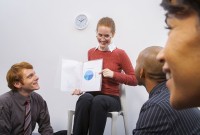- Home
- Business Processes
- Industry Knowledge
- Aerospace Industry
- Automotive Industry
- Banking Domain
- BFSI Industry
- Consumer/ FMCG Industry
- Chemicals Industry
- Engineering & Construction
- Energy Industry
- Education Domain
- Finance Domain
- Hospitality Domain
- Healthcare Industry
- Insurance Domain
- Retail Industry
- Travel and Tourism Domain
- Telecom Industry
- Leadership Skills
- eLearning
- Home
- Leadership
- Leadership Theories
- Contingency Theories in Action
Contingency Theories in Action
Contingency theory suggests matching the best leader to a specific situation based on situational factors and the leadership style. The practical application of theory can be done in various ways. The workplace example is to determine the best candidate for a given set of requirements using the LPC score. Applying the model to determine a leader's ability to adapt in the scenario of a new project etc..
Recap of Learnings from Contingency Theory:
Fielder’s contingency theory matches the leader to the situations by using the Least Preferred Co-Worker (LPC) model. A leader can perform effectively in certain roles and exhibit weakness in different situations based on three variables defined in the earlier article which predicts the favorability of the situation, while the leader’s LPC score determines the ability to function in the required task.
One can make use of the contingency theory to determine the best candidate for a given set of job requirements for effectiveness of a person in that role as by measuring a leader’s LPC score and the three situational variables, one can predict whether the leader is going to be effective in a particular setting. By assessing these three situational variables, one can place any organizational context in one of the eight categories represented in previous article. Once the nature of the situation is determined, the fit between the leader’s style and the situation can be evaluated.
Key Strengths of Contingency Theory:
1. Contingency theory is grounded in research as many researchers have tested it and found it to be a valid and reliable approach to explaining how effective leadership can be achieved.
2. This theory considers the impact of situations on leaders and focuses on the relationship between the leader’s style and the demands of various situations.
3. Third, contingency theory has predictive power and based on conclusions from LPC scale and understanding the context of the workplace situation one can determine the probability of success for a given person in a given situation.
4. From an organizational perspective it supports identification of optimal roles based on individual leadership styles and placing leaders in charge of situations that are ideal for their leadership style.
Practical Applications of the Theory:
Contingency theory has many applications in the organizational world:
1. Can be used to assess the effectiveness of an individual in a particular role and look at the reasons for one’s effectiveness or ineffectiveness.
2. Can be used to predict whether a person who has worked well in one position in an organization will be equally effective in another position having different situational variables when compared to the existing position based on the contingencies that make one’s style effective.
3. Can help in implementing changes in the roles and responsibilities that management might need to make to bring effectiveness to the role of the person leading the same.
Fiedler’s theory does not hold that leaders can adapt their styles to different situations as according to him personality is relatively stable. According to this model improving effectiveness involves changing the situation to fit the leader sometimes also referred to as “job engineering”.
As now we have more understanding of leadership and its challenges in the 21st century organizational context, contingency model might not be the best leadership model to use in most situations, but still can be a powerful tool to analyze a particular situation to determine whether to focus on tasks or relationships. This model sometimes can give an inaccurate picture of your leadership style as it relies heavily on the LPC scale, which has been questioned for its face validity and workability. Further this model does not fully explain how organizations can use the results of this theory in situational engineering and hence we recommend taking a cautious approach and using your own judgment to analyze the situation from all angles.
Related Links
You May Also Like
-
The multiple linkage model states that leadership effectiveness is based on six variables. Multiple variables of a leader's behavior and situation have a linkage to the performance of the individual follower and work unit performance. The theory is based on the notion of the link between the organization process and managerial influence.
-
McGregor's Theory X and Theory Y
McGregor created Theory X and Theory Y of human work motivation and explained two styles of management known as authoritarian (Theory X) and participative (Theory Y). Theory X management assumes most people will attempt to avoid work whereas Theory Y managers trust their people to take ownership of their work.
-
Bass's Transformational Leadership Theory
Bass Transformational Leadership Theory is based on performance beyond expectations approach which defines four elements of transformational leadership. The 4 elements described by Bernard A. Bass in 1985 are Idealised Influence, Intellectual Stimulation, Individualised Consideration, and Inspirational Motivation. This study highlights four key insights about performance beyond expectations and associated criteria to measure it.
-
Self-Fulfilling Prophecy (SFP) Leader Theory
Pygmalion theory of Leadership is a model of SFP at work involving supervisory expectancy based on the pygmalion effect. This effect is a type of self-fulfilling prophecy (SFP) in which raising leader's expectations regarding subordinate performance boosts the group's performance. Managers who are led to demand more from their team, lead the team to better performance. There is some evidence that the SFP effect does exists.
-
The psychodynamic approach to leadership has its roots in the work done by Sigmund Freud. These involved psychological theories of personality development and explaining leadership using psychoanalytic concepts. It tries to define a person is in terms of personality traits. Personality structured into three parts (i.e., tripartite) - the id, ego, and superego.
-
Trait theories of leadership explain the leadership traits that have been studied to determine what makes certain people great leaders. The practical application of the theory is looking at how the leader‟s behavior affects their subjects.
-
The Fiedler Model of leadership is a contingency theory and states that a leader's effectiveness is based on the situation. There is no one best style of leadership and the effectiveness of a leader in an organization depends on matching the leader to the situation. Leaders should determine the natural leadership style and assess the situation to flex the style.
-
Process & Stages of Creativity
Creative ideas do not come just like that. There is a process to it. There are a number of techniques of creativity to support the generation of ideas but the widely practiced ones are brainstorming and lateral thinking. Most innovations are not so much the product of sudden insights as they are the result of a conscious process that often goes through multiple stages. The creative process can be divided into four stages of preparation, incubation, evaluation, and implementation.
-
The development of teams is an ongoing process because the composition of the team may keep on changing. The new members may join and the old members may leave the team. The team members pass through several stages for the development of the team and there has been a lot of research to identify these stages. In this article, we discuss the common theories of team development.
-
Reciprocal influence theory also known as reciprocal determinism is authored by Albert Bandura and states that an individual's behavior influences and is influenced by both the social world and personal characteristics. Three factors that influence behavior are the environment, the individual, and the behavior itself. Certain leader behaviors can cause subordinate behaviors and reciprocal influence on the leader by the group.
Explore Our Free Training Articles or
Sign Up to Start With Our eLearning Courses

About Us
Learning
© 2023 TechnoFunc, All Rights Reserved










